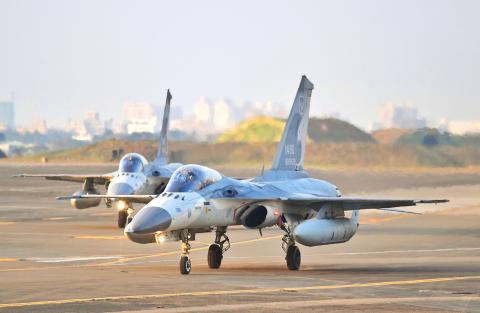The Ministry of National Defense has announced that it plans to develop a new generation of homegrown fighter jets with stealth capabilities as part of the government’s policy to develop an indigenous defense industry.
“Building homegrown aircraft and vessels has become an extremely important policy of the ministry since President Tsai Ing-wen (蔡英文) assumed office. Progress has been made in building indigenous vessels and there is another promise the ministry has to keep, which is to develop a new generation of fighter jets,” Minister of National Defense Feng Shih-kuan (馮世寬) said on Monday.
Feng made the announcement during a meeting with reporters, but did not give any details about the design or functions of the new aircraft.

Photo: CNA
According to reports, the new fighter jet is to be a double-engine stealth plane developed with Taiwanese technology.
The National Chung-Shan Institute of Science and Technology has reportedly been developing the engine technology based on the model fitted on the Indigenous Defense Fighter (IDF).
The air force’s Aviation Technology Research Center is also to be responsible for the development of the new fighter jets.
The research center, though receiving little public attention, is critical for refining the nation’s air defense capabilities in the next 10 to 20 years, Feng said.
While the nation is still seeking to procure F-35Bs, the short takeoff and vertical-landing variant of the US stealth jet that could satisfy the nation’s defense needs due to the vulnerability of air bases, Taiwan has to develop its own fighter jets to maintain its defense capabilities and increase the possibility of procurement, Feng said.
The development of homegrown fighter jets is key to the nation’s defense industry, as Aerospace Industrial Development Corp, which designed and built the IDF when it was an air force research division, is now the nation’s largest defense company, Feng said.
However, senior military analyst Erich Shih (施孝瑋) said that the IDF engine, with its inadequate thrust, could not be used to power next-generation fighter jets.
A capable engine on next-generation fighter jets should produce at least 24,000 pounds of thrust, but an IDF’s two engines can only produce up to 18,000 pounds of thrust, making the IDF engine unfit for the new jets, Shih said.
Since the development of the IDF in the 1990s, Taiwan has made little progress in military aviation or technological cooperation with other nations — such as an aborted plan to partner with an Italian manufacturer to build trainer jets for the air force — but building new jets is a more efficient option, both technologically and financially, to advance the nation’s aerospace industry, he said.

The brilliant blue waters, thick foliage and bucolic atmosphere on this seemingly idyllic archipelago deep in the Pacific Ocean belie the key role it now plays in a titanic geopolitical struggle. Palau is again on the front line as China, and the US and its allies prepare their forces in an intensifying contest for control over the Asia-Pacific region. The democratic nation of just 17,000 people hosts US-controlled airstrips and soon-to-be-completed radar installations that the US military describes as “critical” to monitoring vast swathes of water and airspace. It is also a key piece of the second island chain, a string of

A magnitude 5.9 earthquake that struck about 33km off the coast of Hualien City was the "main shock" in a series of quakes in the area, with aftershocks expected over the next three days, the Central Weather Administration (CWA) said yesterday. Prior to the magnitude 5.9 quake shaking most of Taiwan at 6:53pm yesterday, six other earthquakes stronger than a magnitude of 4, starting with a magnitude 5.5 quake at 6:09pm, occurred in the area. CWA Seismological Center Director Wu Chien-fu (吳健富) confirmed that the quakes were all part of the same series and that the magnitude 5.5 temblor was

Taiwan will now have four additional national holidays after the Legislative Yuan passed an amendment today, which also made Labor Day a national holiday for all sectors. The Chinese Nationalist Party (KMT) and Taiwan People’s Party (TPP) used their majority in the Legislative Yuan to pass the amendment to the Act on Implementing Memorial Days and State Holidays (紀念日及節日實施辦法), which the parties jointly proposed, in its third and final reading today. The legislature passed the bill to amend the act, which is currently enforced administratively, raising it to the legal level. The new legislation recognizes Confucius’ birthday on Sept. 28, the

The Central Weather Administration has issued a heat alert for southeastern Taiwan, warning of temperatures as high as 36°C today, while alerting some coastal areas of strong winds later in the day. Kaohsiung’s Neimen District (內門) and Pingtung County’s Neipu Township (內埔) are under an orange heat alert, which warns of temperatures as high as 36°C for three consecutive days, the CWA said, citing southwest winds. The heat would also extend to Tainan’s Nansi (楠西) and Yujing (玉井) districts, as well as Pingtung’s Gaoshu (高樹), Yanpu (鹽埔) and Majia (瑪家) townships, it said, forecasting highs of up to 36°C in those areas